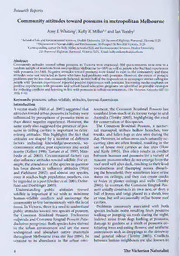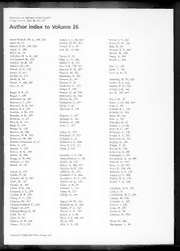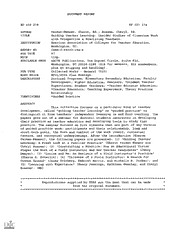
Mechanical Properties of Gas Metal Arc and Friction - DiVA Portal PDF
Preview Mechanical Properties of Gas Metal Arc and Friction - DiVA Portal
Mechanical Properties of Gas Metal Arc and Friction Stir AA6082-T6 Weldments Christina Rødsand Breivik Materials Technology Submission date: June 2013 Supervisor: Trond Furu, IMTE Co-supervisor: Øystein Grong, IMT Norwegian University of Science and Technology Department of Materials Science and Engineering Preface The present report is part of an international collaboration project between Norway and Qatar,wheretheinvolvedcompanieshavebeenHydroAluminium,QatarPetroleumand Qatalum. ThetriptoQatarinthebeginningoftheprojectwasveryinformativeandofgreatinspira- tionandmotivationforthefurtherwork. SupervisorsandcontactsduringtheworkhavebeenprofessorØysteinGrong1andTrond Furu2. IwouldliketogiveaspecialthankstoprofessorØysteinGrongforhisthorough and constructive guidance. In addition, I would like to thank all the other individuals assistingmeduringtheproject. Trondheim,June2013 ChristinaBreivik 1NorwegianUniversityofScienceandTechnology(NTNU),Trondheim 2HydroAluminium,Sunndalsøra i ii Abstract The general purpose of the presents report is to determine the mechanical properties of AA6082-T6 subsequent to gas metal arc welding (GMAW) and friction stir welding (FSW).Hardnesstestinghasbeencarriedoutfortheweldments. Inaddition,tensileand CharpyV-notchtestinghasbeencarriedoutfortheunaffectedbasemetal,thefusion/stir zoneandfortheheat-affectedzone(HAZ),bothtransverseandlongitudinaltotheweld- ing/extrusiondirection. ItisconcludedthatHAZsofteningisamajorproblembothintheGMAandtheFSweld- ments. Still,thetotalwidthoftheHAZintheFSweldmentsissmallercomparedtothat observed in the GMA weldments. The total strength reduction for the GMA and the FS welds was 43 and 34%, respectively. The general observations is that the FS weldments showslightlybettermechanicalpropertiescomparedtotheGMAweldments. Thisisfur- ther reflected in the calculations of load-bearing capacity of the joints, showing that the FSweldmentsexhibitthehighestcapacityunderotherwiseidenticalconditionsduetothe combinedeffectofalowerHAZstrengthreductionandasmallerHAZwidth. iii iv Sammendrag Detgenerelleforma˚letmeddennerapportenera˚ bestemmedemekaniskeegenskapenetil AA6082-T6pa˚følgendeavgassveising(GMAW)ogfriksjonssveising(FSW).Detharblitt foretatthardhetsma˚lingerlangsdenvarmepa˚virkedesonen(HAZ).Itilleggharstrekk-og ska˚rslagstesingblittgjennomførtfordetupa˚virkedegrunnmaterialet,forsmelte/røresone, og for HAZ. Prøvene har blitt tatt ut enten pa˚ tvers eller pa˚ langs av ektruderingsretnin- gen. Det har blitt konkludert med at HAZ mykning er et stor problem ba˚de ved GMAW og ved FSW. Likevel blir den totale bredden av HAZ mye smalere ved FSW sammenlignet medGMAW.DentotalestyrkereduksjonenvedGMAWogFSWvarhenholdsvispa˚43og 34%. GenereltviserFS-sveisenebedremekaniskeegenskapersammenlignetmedGMA- sveisene. Dettestøttesavberegningenegjortforlastbærenedekapasitetavsveisene,som viser at FS-sveisene har større kapasitet sammenlignet med GMA-sveisene under like forhold. Dette kan forklares med den kombinerte effekten av lavere HAZ styrkereduk- sjonogsmalerebreddepa˚ HAZ. v vi Contents Preface i Abstract iii Sammendrag v Contents viii 1 Introduction 1 2 Theory 3 2.1 PhysicalmetallurgyofAl-Mg-Sialloys . . . . . . . . . . . . . . . . . . 3 2.1.1 Processroute . . . . . . . . . . . . . . . . . . . . . . . . . . . . 4 2.1.2 Grainstructureandtexture . . . . . . . . . . . . . . . . . . . . . 5 2.1.3 Precipitationhardening . . . . . . . . . . . . . . . . . . . . . . . 6 2.1.4 Fracturemechanisms/mechanicalproperties . . . . . . . . . . . . 7 2.2 GasMetalArcWeldingofAl-Mg-Sialloys . . . . . . . . . . . . . . . . 8 2.2.1 TheGMAWprocess . . . . . . . . . . . . . . . . . . . . . . . . 8 2.2.2 Thefusionzone . . . . . . . . . . . . . . . . . . . . . . . . . . . 9 2.2.3 Theheat-affectedzone . . . . . . . . . . . . . . . . . . . . . . . 12 2.3 FrictionStirWeldingofAl-Mg-Sialloys . . . . . . . . . . . . . . . . . . 14 2.3.1 TheFSWprocess . . . . . . . . . . . . . . . . . . . . . . . . . . 14 2.3.2 Nugget/stirzone(SZ). . . . . . . . . . . . . . . . . . . . . . . . 15 2.3.3 Thermo-mechanicallyaffectedzone . . . . . . . . . . . . . . . . 16 2.3.4 TheFSWheat-affectedzone . . . . . . . . . . . . . . . . . . . . 16 2.3.5 Mechanicalpropertiesoffrictionstirwelds . . . . . . . . . . . . 17 2.4 Load-bearingcapacityofweldedcomponents . . . . . . . . . . . . . . . 18 3 Experimental 21 3.1 Basematerial . . . . . . . . . . . . . . . . . . . . . . . . . . . . . . . . 21 3.1.1 Chemicalcomposition . . . . . . . . . . . . . . . . . . . . . . . 21 vii 3.1.2 Castingandhomogenizationconditions . . . . . . . . . . . . . . 21 3.1.3 Extrusionandheat-treatment . . . . . . . . . . . . . . . . . . . . 22 3.2 Weldingofthesheets . . . . . . . . . . . . . . . . . . . . . . . . . . . . 22 3.2.1 Gasmetalarcwelding . . . . . . . . . . . . . . . . . . . . . . . 22 3.2.2 Frictionstirwelding . . . . . . . . . . . . . . . . . . . . . . . . 23 3.3 Samplepreparationandmetallographicexamination. . . . . . . . . . . . 23 3.3.1 Opticalmicroscopy . . . . . . . . . . . . . . . . . . . . . . . . . 24 3.3.2 Hardnesstesting . . . . . . . . . . . . . . . . . . . . . . . . . . 24 3.4 Tensiletesting . . . . . . . . . . . . . . . . . . . . . . . . . . . . . . . . 25 3.5 Impacttesting . . . . . . . . . . . . . . . . . . . . . . . . . . . . . . . . 27 3.6 FracturesurfaceanalysisintheScanningElectronMicroscope(SEM) . . 29 4 Results 31 4.1 OpticalmicrographsofGMAandFSwelds . . . . . . . . . . . . . . . . 31 4.2 HardnessprofilesofGMAandFSwelds . . . . . . . . . . . . . . . . . . 33 4.3 Tensiletestresults . . . . . . . . . . . . . . . . . . . . . . . . . . . . . . 34 4.3.1 GMAW . . . . . . . . . . . . . . . . . . . . . . . . . . . . . . . 34 4.3.2 FSW . . . . . . . . . . . . . . . . . . . . . . . . . . . . . . . . 40 4.4 Fractographyofthetensilespecimens . . . . . . . . . . . . . . . . . . . 45 4.4.1 GMAW . . . . . . . . . . . . . . . . . . . . . . . . . . . . . . . 45 4.4.2 FSW . . . . . . . . . . . . . . . . . . . . . . . . . . . . . . . . 48 4.5 CharpyV-notchtestresults . . . . . . . . . . . . . . . . . . . . . . . . . 53 4.5.1 GMAW . . . . . . . . . . . . . . . . . . . . . . . . . . . . . . . 53 4.5.2 FSW . . . . . . . . . . . . . . . . . . . . . . . . . . . . . . . . 58 5 Discussion 63 5.1 ComparisonofmechanicalpropertiesbetweentheGMAandtheFSweld- ments . . . . . . . . . . . . . . . . . . . . . . . . . . . . . . . . . . . . 63 5.2 Hardnessprofilesandyieldstress . . . . . . . . . . . . . . . . . . . . . . 69 5.2.1 Comparisonofthehardnessprofiles . . . . . . . . . . . . . . . . 69 5.2.2 Relationshipbetweenhardnessprofilesandyieldstress . . . . . . 72 5.3 Load-bearingcapacityofGMAandFSwelds . . . . . . . . . . . . . . . 74 5.3.1 Loadingperpendiculartoweld . . . . . . . . . . . . . . . . . . . 74 5.3.2 Loadingparalleltoweld . . . . . . . . . . . . . . . . . . . . . . 75 6 Conclusion 79 7 Bibliography 81 Appendix 85 viii
Description:The list of books you might like

The Subtle Art of Not Giving a F*ck

The Sweetest Oblivion (Made Book 1)

The Mountain Is You

Do Epic Shit

The Annotated Big Sleep

Gluten-Free Bread

Bürgerliches Recht I: Fall · Systematik · Lösung Allgemeiner Teil
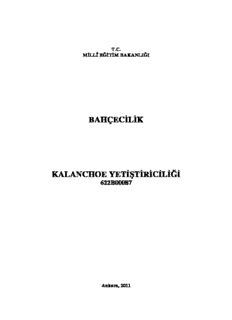
bahçecilik kalanchoe yetiştiriciliği
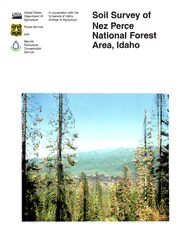
Soil Survey of Nez Perce National Forest Area, Idaho (2006)
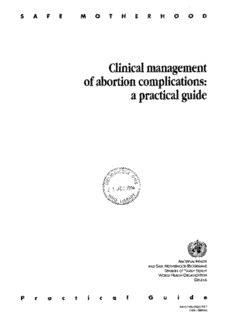
C ' ical management of abortion complications - World Health
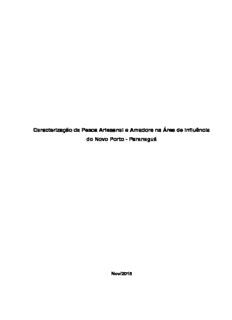
Caracterização da Pesca Artesanal e Amadora na Área de Influência do Novo Porto
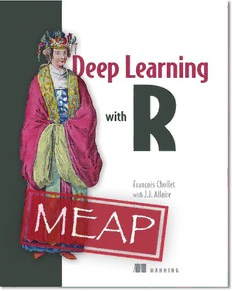
Deep Learning with R
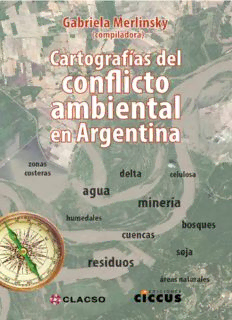
CARTOGRAFÍAS DEL CONFLICTO AMBIENTAL EN ARGENTINA
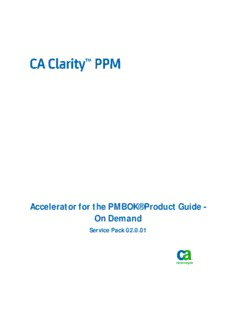
CA Clarity PPM Accelerator for the PMBOK Product Guide - On
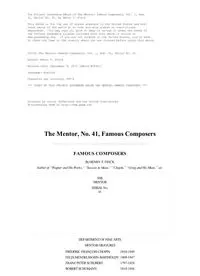
The Mentor No 41 Famous Composers by Henry T Finck
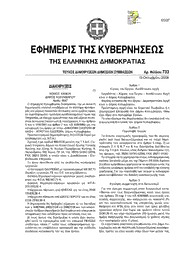
Greek Government Gazette: Part 7, 2006 no. 733

Die Freiheit der Meere und der Künftige Friedensschluß
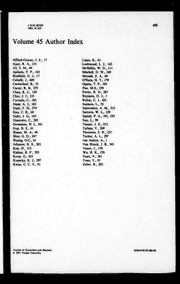
Journal of Economics and Business 1993: Vol 45 Index
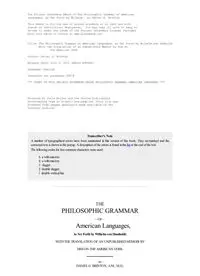
The Philosophic Grammar of American Languages by Daniel G Brinton

